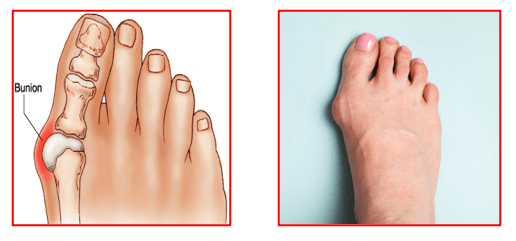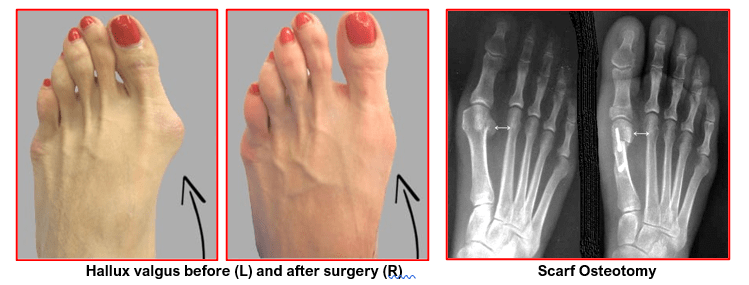Hallux Valgus (Bunion)
A bunion, also known as hallux valgus, is bony prominence at the base of the big toe. This often results in pain, redness and rubbing in footwear.
The 1st metatarsal bone abnormally angles outwards towards the other foot from its joint in the midfoot. There is resultant deviation of the phalanges towards the second toe. Bunions changes the shape of patient’s feet which makes it difficult for them to find correctly fitting shoes. Their symptoms worsen if left untreated.

The possible causes for bunion formation include:
- Family history and genetics
- Arthritis (inflammation of the joints) including rheumatoid arthritis, psoriatic arthritis and gout
- Neuromuscular conditions such as cerebral palsy (affects movement and co-ordination)
- Connective tissue disorders such as Marfan’s syndrome (affects the connective tissues)
- Tight fitting shoes that are too tight, narrow or high heeled.
The main indication of a bunion is the pointing of the big toe towards the other toes of the foot. Other signs and symptoms include:
- Pain and swelling over the big toe that increases while wearing shoes
- Swelling with red, sore and calloused skin at the base of the big toe
- Inward turning of the big toe pushes the second toe out of place
- Bony bump at the base of the big toe
- Sore skin over the bony bump
Difficulty walking and wearing shoes
The diagnosis of a bunion is based on patient’s medical history, thorough clinical examination, appropriate x-rays of the foot.
The surgeon checks for the extent of misalignment of the lower leg and foot and also damage to the soft tissues. Your surgeon will usually order weight bearing X-rays (i.e. taken while standing) to access the severity of the bunion and deformity of the toe joints.
Conservative treatments are initially recommended to all patients with the aim of reducing or eliminating patient’s foot pain.
Such measures can include:
- Medications for relieving pain and inflammation
- Wearing surgical shoes with a wide and high toe box, avoiding tight, pointed or high-heeled shoes.
- Use of orthotics to realign the bones of your foot and ease pain.
- Padding the bunions
- Ice applications several times a day
Conservative treatments do help relieve the discomfort of a bunion, but these measures give temporary relief and do not prevent the bunion from becoming worse.
Surgery is the only means of correcting a bunion. It is recommended when conservative measures fail to treat the symptoms of a bunion or patients present with advanced stage of toe deformity
There are many surgical options to treat a bunion. The surgical aim is to realign the bones in the foot, correct the deformity, and relieve pain and discomfort. The surgery is performed as a day procedure, under the effect of a light general anaesthetic and a regional nerve block or a spinal anaesthesia. Patients can start walking same day after GA or next day after spinal anaesthesia
Osteotomy is a common type of bunion surgery that involves the surgical cutting and realignment of the bones around the affected big toe.
Surgeons select the appropriate surgical procedure based on the type of bunion and its severity.
There are 3 main types of osteotomies used by foot and ankle surgeons -
Akin osteotomy, Chevron osteotomy, and Scarf osteotomy.
Akin osteotomy:
Akin osteotomy corrects the sideways deviation of the big toe. In this procedure, your surgeon makes a small cut in the proximal phalanx (base of the big toe) and removes a wedge of bone to straighten the big toe. The bony fragments are then stabilized using a screw or staples. This procedure is often used in conjunction with the other procedures below.
Chevron osteotomy:
A chevron osteotomy is usually recommended for mild to moderate bunion deformities. During this procedure, the surgeon makes an incision over your big toe. The joint capsule is opened, and the bunion is removed using a surgical saw. A V-shaped cut is made on your big toe and the metatarsal bones are shifted to bring your toe into its normal anatomical position. The bunion is then shaved, and the soft tissues are realigned to correct the position. Akin osteotomy may be performed if necessary. The mobility of your big toe is examined, and the capsule and wound are re-approximated with sutures. Screws or pins are used to hold the bones in their new position until healing takes place. This procedure can also be performed minimally invasively with keyhole style incisions.
Scarf osteotomy:
Scarf osteotomy is usually recommended for moderate to severe bunion deformities. The surgeon makes an incision along your big toe and opens the joint capsule to expose the bump. The bump on your big toe is then removed using a bone saw. Your first metatarsal bone is then cut in a pre-marked Z shape and then realigned to correct the deformity. Your surgeon will fix the cut bone with pins or screws. The joint capsule and surgical wounds are then re-approximated using dissolvable sutures keeping your toe in a straight position. This is a very powerful corrective procedure with excellent long-term results.
Arthrodesis:
This surgery involves fusing the two bones that form the big toe metatarsophalangeal (MTP) joint. This procedure is used for severe bunions and when arthritis is present. The movement of your big toe is reduced following this procedure, but pain and deformity are very well controlled.
Bunion surgery does involve certain risks and complications:
- Infection
- Recurrence of the bunion
- Nerve damage
- Unresolved pain and swelling
- Joint stiffness or restricted movements
- Delayed bone healing or healing in the wrong position
- In rare cases, a second surgery may be necessary to correct the problems.
Bunion surgery does involve certain risks and complications:
- Infection
- Recurrence of the bunion
- Nerve damage
- Unresolved pain and swelling
- Joint stiffness or restricted movements
- Delayed bone healing or healing in the wrong position
- In rare cases, a second surgery may be necessary to correct the problems.
Patients should follow all instructions given by their surgeon after their surgery.
- Wearing specially designed postoperative shoes to protect the wounds and assist in walking. Patients are advised to heel weight bear with help of elbow crutches for support.
- Painkillers are taken as and when needed.
- Ice packs are done 4 to 5 times a day to reduce pain and swelling
- Keep dressings dry and leave them in place until their next outpatient visit. Wounds are checked and any sutures removed at 2 weeks.
- Minimize walking where possible.
- Elevate the foot when resting or lying down in-order to minimize swelling as much as possible for the first 6 weeks.
- It may not be possible to wear regular shoes for 6 to 8 weeks after surgery due to swelling.
Book An Appointment
Private Clinics : Locations & Directions
London Joints Clinic (Pune)
Address
Office S 5, 2nd Floor, North Block, Sacred World Mall,
Opp Sacred Heart Township, Near Jagtap Chowk,
Wanawadi, Pune 411040
Monday, Wednesday & Friday 7 PM to 9 PM
Sunday 11 AM to 1 PM
Appointments
London Joints Clinic ( PCMC )
Address
C/O Dr Nitin’s Physio Clinic,
Opp. Brahma Hotel,
Near Akurdi Post Office,
Vivek Nagar,
Akurdi,
Pune 411035
Saturdays only 4.30 PM to 7.30 PM
Appointments
Hospitals OPDs : Locations & Directions
Manipal Hospital

Address
Manipal Hospital, Opp D Mart, Baner-Mhalunge Road, Baner, Pune 411 045
Monday to Saturday 11 AM to 4 PM
Appointments
Contact us
Dr Anand Jadhav has a centralised appointment system for all locations across various hospitals and clinics in Pune & PCMC areas
Appointment Bookings & Requests can be made by any method :

